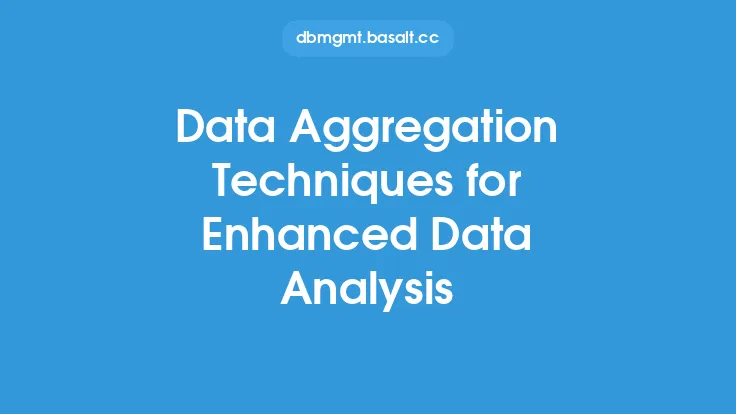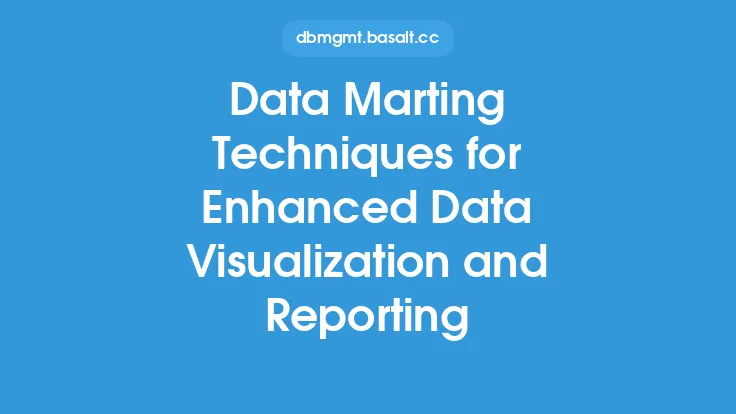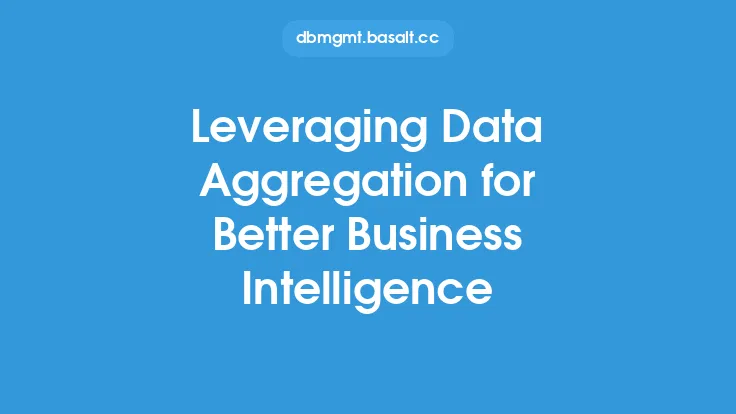Data aggregation is a crucial step in the data analysis process, as it enables organizations to summarize and analyze large datasets, identify trends, and make informed decisions. With the increasing amount of data being generated every day, data aggregation techniques have become essential for extracting insights and value from data. In this article, we will delve into the world of data aggregation techniques, exploring their importance, types, and applications in data analysis.
Introduction to Data Aggregation
Data aggregation is the process of combining data from multiple sources into a single, unified view. This technique helps to reduce data complexity, improve data quality, and facilitate analysis. Data aggregation involves applying various mathematical and statistical functions to data, such as sum, average, count, and group by, to extract meaningful information. The goal of data aggregation is to provide a concise and accurate representation of the data, making it easier to analyze and interpret.
Types of Data Aggregation Techniques
There are several types of data aggregation techniques, each with its own strengths and weaknesses. Some of the most common techniques include:
- Rollup Aggregation: This technique involves aggregating data from a detailed level to a higher level of granularity. For example, aggregating sales data from individual products to product categories.
- Drill-Down Aggregation: This technique involves aggregating data from a higher level of granularity to a more detailed level. For example, aggregating sales data from product categories to individual products.
- Group By Aggregation: This technique involves aggregating data based on one or more attributes. For example, aggregating sales data by region, product category, or customer segment.
- Pivot Table Aggregation: This technique involves aggregating data using a pivot table, which allows for easy rotation and aggregation of data.
- Data Cubes Aggregation: This technique involves aggregating data using a data cube, which is a multidimensional representation of data.
Data Aggregation Methods
Data aggregation methods refer to the specific techniques used to aggregate data. Some common data aggregation methods include:
- Summation: This method involves calculating the sum of a set of values.
- Averaging: This method involves calculating the average of a set of values.
- Counting: This method involves counting the number of occurrences of a specific value or attribute.
- Grouping: This method involves grouping data based on one or more attributes.
- Ranking: This method involves ranking data based on a specific attribute or value.
Data Aggregation Tools and Technologies
There are several data aggregation tools and technologies available, each with its own strengths and weaknesses. Some of the most common tools and technologies include:
- Relational Databases: Relational databases, such as MySQL and Oracle, provide built-in aggregation functions, such as sum, average, and count.
- Data Warehouses: Data warehouses, such as Amazon Redshift and Google BigQuery, provide advanced aggregation capabilities, including rollup and drill-down aggregation.
- Big Data Technologies: Big data technologies, such as Hadoop and Spark, provide distributed aggregation capabilities, allowing for the processing of large datasets.
- Data Visualization Tools: Data visualization tools, such as Tableau and Power BI, provide interactive aggregation capabilities, allowing users to easily explore and analyze data.
- ETL Tools: ETL (Extract, Transform, Load) tools, such as Informatica and Talend, provide data aggregation capabilities, allowing for the transformation and loading of data into a target system.
Best Practices for Data Aggregation
To ensure effective data aggregation, it is essential to follow best practices, including:
- Define Clear Aggregation Requirements: Clearly define the aggregation requirements, including the data sources, aggregation methods, and desired output.
- Choose the Right Aggregation Tool: Choose the right aggregation tool or technology, based on the specific requirements and data characteristics.
- Ensure Data Quality: Ensure data quality, by handling missing or duplicate data, and performing data validation and cleansing.
- Optimize Aggregation Performance: Optimize aggregation performance, by using indexing, caching, and parallel processing techniques.
- Document Aggregation Processes: Document aggregation processes, including the aggregation methods, data sources, and output, to ensure transparency and reproducibility.
Common Challenges in Data Aggregation
Data aggregation can be challenging, and common challenges include:
- Data Quality Issues: Data quality issues, such as missing or duplicate data, can affect the accuracy and reliability of aggregated data.
- Scalability Issues: Scalability issues, such as processing large datasets, can affect the performance and efficiency of data aggregation.
- Complexity Issues: Complexity issues, such as handling multiple data sources and aggregation methods, can affect the ease of use and maintainability of data aggregation processes.
- Security Issues: Security issues, such as ensuring data privacy and access control, can affect the security and compliance of data aggregation processes.
- Interoperability Issues: Interoperability issues, such as integrating with different data sources and systems, can affect the flexibility and adaptability of data aggregation processes.
Future of Data Aggregation
The future of data aggregation is exciting, with emerging trends and technologies, such as:
- Artificial Intelligence: Artificial intelligence, such as machine learning and deep learning, can be used to automate and optimize data aggregation processes.
- Cloud Computing: Cloud computing, such as cloud-based data warehouses and big data technologies, can provide scalable and on-demand data aggregation capabilities.
- Internet of Things: Internet of things, such as sensor data and device data, can provide new opportunities for data aggregation and analysis.
- Real-Time Data Aggregation: Real-time data aggregation, such as streaming data and event-driven architecture, can provide instant insights and decision-making capabilities.
- Data Aggregation as a Service: Data aggregation as a service, such as cloud-based data aggregation platforms, can provide easy and affordable access to data aggregation capabilities.





